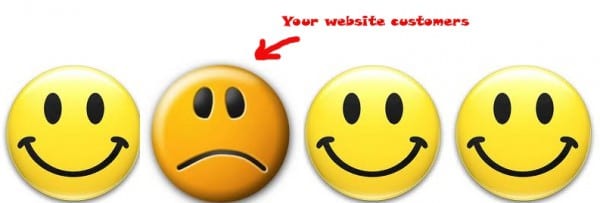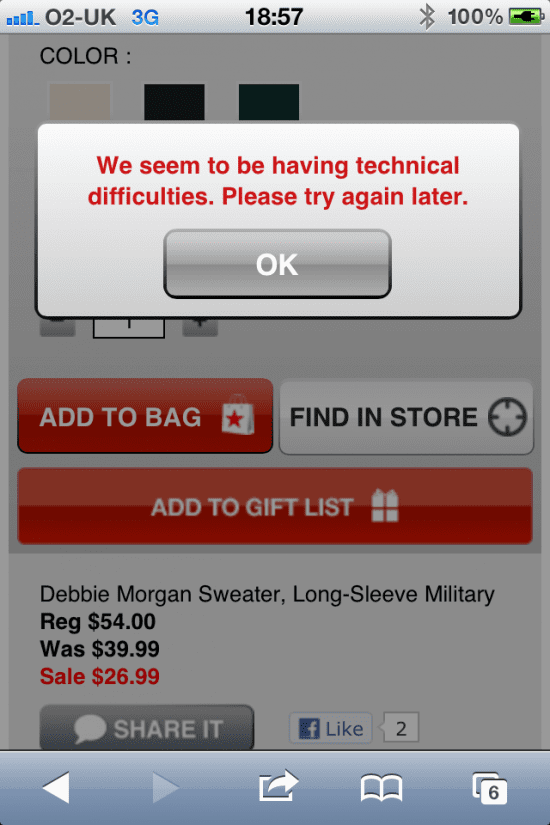Good User Experience = Good Customer Service = More Sales
 Christmas shopping has begun and with it, the stress! And no, I haven’t been shopping offline at all, I’ve been shopping online! But this time of the year always brings to the fore one of the most obvious issues that many Ecommerce Managers have control of, but yet remains to be one of the most lacking in terms of solutions.
Christmas shopping has begun and with it, the stress! And no, I haven’t been shopping offline at all, I’ve been shopping online! But this time of the year always brings to the fore one of the most obvious issues that many Ecommerce Managers have control of, but yet remains to be one of the most lacking in terms of solutions.
Picture this: you go into a store where a very nice assistant helps you find everything you need to purchase. You’re thinking “Great! All my Christmas shopping done in an hour!”.
You walk on up to the till point where the assistant starts totting up all of your purchases, but the sales assistant then suddenly tells you that you can’t actually pay at their till unless you have a specific device. So you have to leave that till point, put ALL of your items back into your trolley and go to a different till.
So, you start again.
At the next till point the sales assistant again starts totting up your items. This time you can pay. They take your card off you and swipe it.
They then say “Sorry- I forgot to say: The total of your goods is £230. But you have to pay £80 tax and £90 for delivery so that’s a total of £400 going on your card. Is that ok?”.
Of course, this scenario didn’t take place in a physical store- but it did happen to me on a well known retailer’s website – how’s that for service? It would have been no worse, if it had occurred in a physical store.
Common user experience problems that affect customer service
Customer experience and User Experience (UX) to an ex-retailer like me, are essentially the same thing. User Experience is a technical method of looking at and fixing websites so that they facilitate good customer service. Problems are all too common as this infographic posted by Dave Chaffey showing why online shoppers abandon illustrates.
If you are an Ecommerce Manager and you aren’t setting aside sufficient time or budget for UX, you may just want to think again. Usually when we talk about UX we think its only got to do with design and usability. Wrong. The very clear example above demonstrates that it can also impact heavily on your ecommerce sales!
Here’s my ‘bug bear’ list of customer service related UX and usability catastrophes that are costing retailers sales:
- 1. Flash only checkouts and mobile sites which just don't work. The speed of uptake of mobile and tablet shopping and that massive growth in sales revenue from mobile is passing you by if your mobile experience is flawed.

- 2. Stock availability problems. You add a product to basket and then only find out that they are out of stock when you go through to checkout – don’t keep out of stock items live on the site.
- 3. Adding Captchas to checkout pages. A sure fire way of losing a sale.
- 4. Pages take forever to load. Your customers won’t wait. Nor will Google for that matter- this can also impact on your website visibility.
- 5. Invisible buttons. If your ‘add to basket’ or 'checkout' buttons aren’t visible without scrolling they can be effectively invisible to your customer.
- 6. Delivery charges added on at the very last minute. Not only are you seriously at risk of breaching UK retail regulations which states that customers should be informed of compulsory charges upfront, you’re at serious risk of losing sales
- 7. Error pages. 404s are still surprisingly common, yet it's easy to review them in your analytics. If you ask a member of supermarket staff where to find a product they don’t shrug and point- they take you to the isle the product is on
- 8. On site search doesn’t work. Because it doesn’t show the expected results or doesn’t show related results on an accidental mis-spelling.
All of the above issues cause abysmal customer service. Bear these in mind when you navigate your website – identify issues that from a customer service point-of-view, ‘annoy’ you and potentially the customers is step one in developing testing hypotheses for A/B or Multivariate testing, to allow you to make changes which will allow you to see an uplift on what’s really important – revenue and customer satisfaction.


 Christmas shopping has begun and with it, the stress! And no, I haven’t been shopping offline at all, I’ve been shopping online! But this time of the year always brings to the fore one of the most obvious issues that many Ecommerce Managers have control of, but yet remains to be one of the most lacking in terms of solutions.
Christmas shopping has begun and with it, the stress! And no, I haven’t been shopping offline at all, I’ve been shopping online! But this time of the year always brings to the fore one of the most obvious issues that many Ecommerce Managers have control of, but yet remains to be one of the most lacking in terms of solutions.


